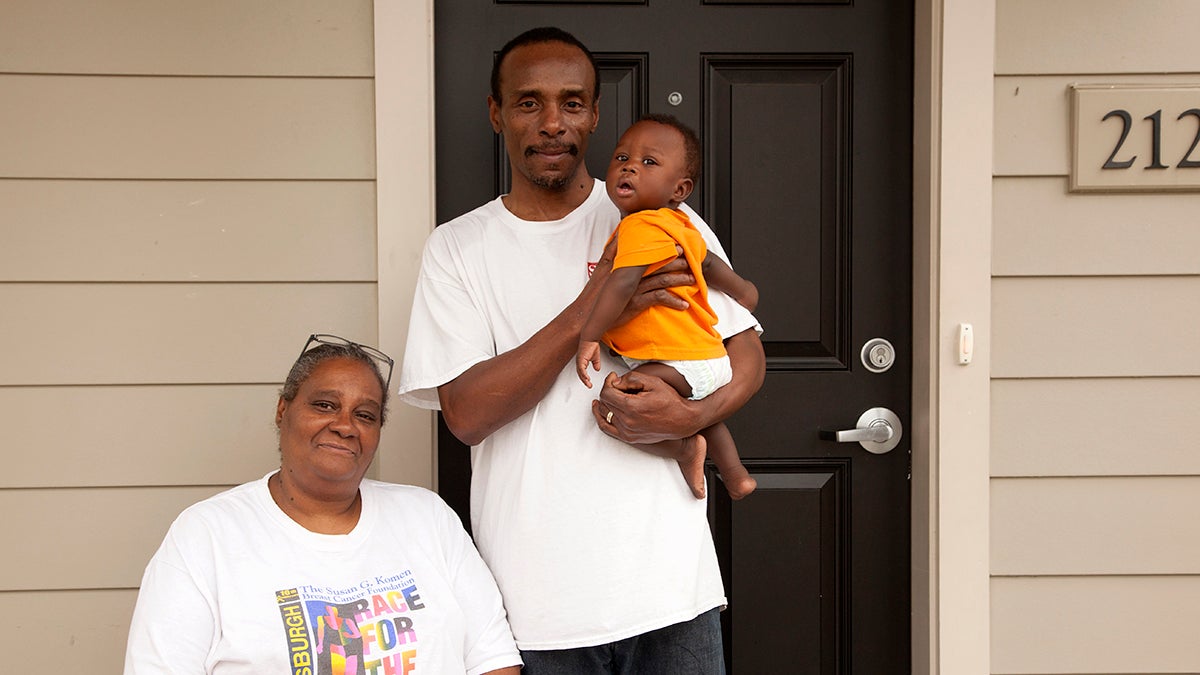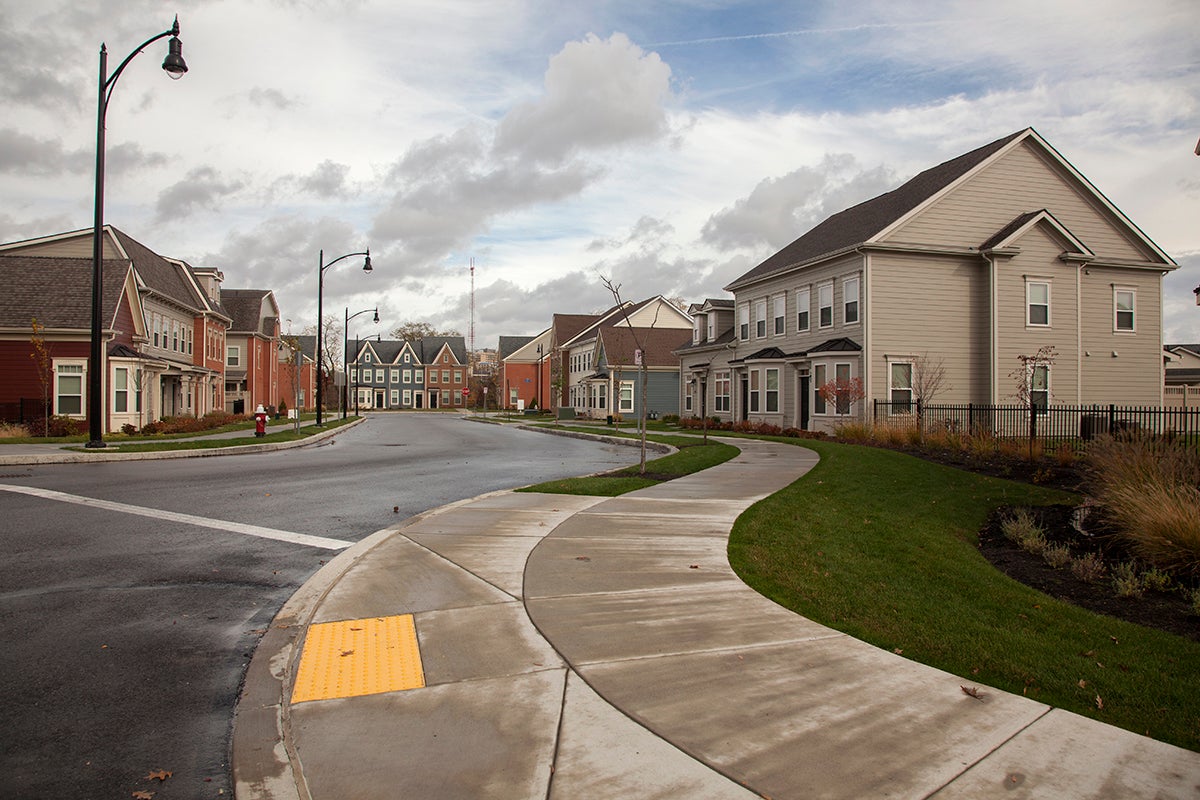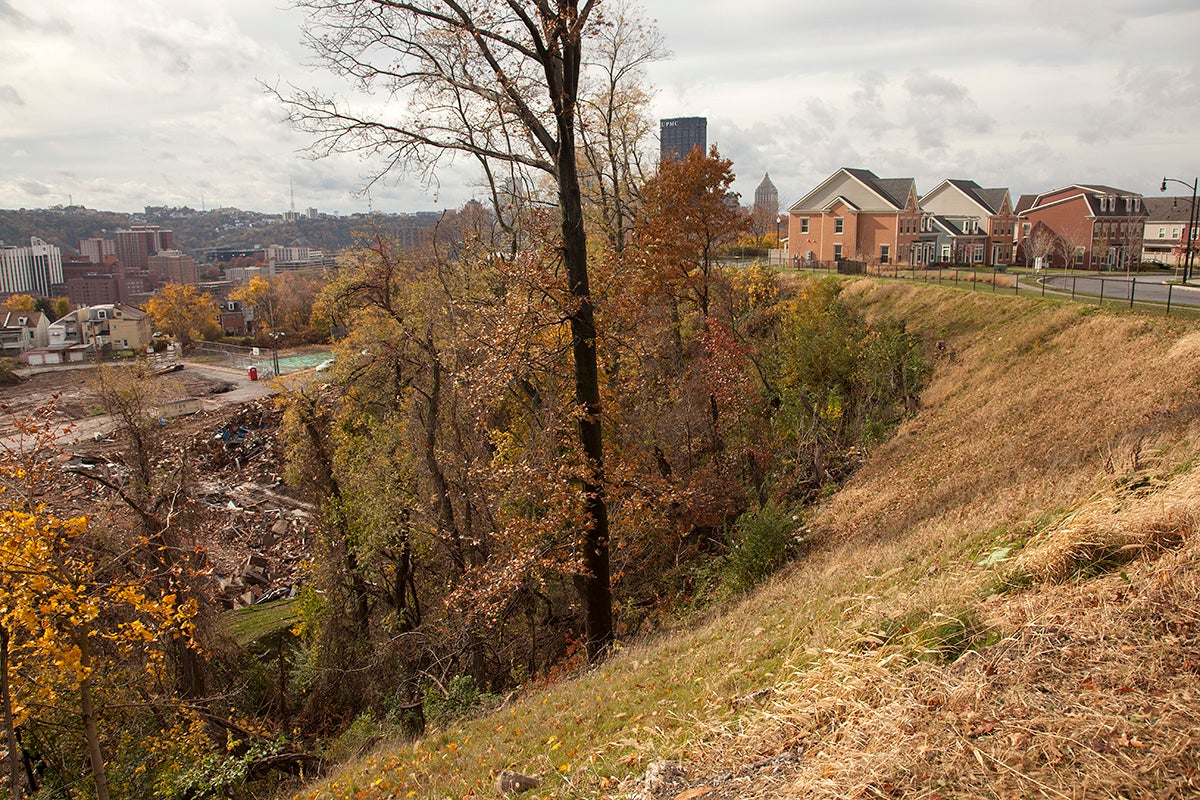A federal pilot program allows local housing authorities more autonomy. Is that a good thing?
Listen
Selena and James Strothers with their grandson, in front of their new home in the Skyline Terrace redevelopment in Pittsburgh. (Irina Zhorov/Keystone Crossroads)
Pennsylvania housing authorities have used a pilot program’s flexibility to redevelop public housing. A look at its benefits, criticisms and future.
UPDATED 12/18/15: Congress’ Omnibus spending bill for 2016 expands the Moving to Work (MTW) program. The bill instructs HUD to designate 100 additional housing authorities as MTW agencies over a period of seven years, and to research and evaluate the program, as well as propose specific policy changes. Further, the bill says “the Secretary shall extend the current Moving to Work agreements of previously designated participating agencies until the end of each such agency’s fiscal year 2028 under the same terms and conditions of such current agreements, except for any changes to such terms or conditions otherwise mutually agreed upon by the Secretary and any such agency…”
As Selena Strothers walked through her new two-bedroom home, a subsidized public housing unit in Pittsburgh’s Hill District, she intoned one phrase over and over, as a mantra.
“I just love it,” she said.
“This is actually our first home,” she said. “We’ve always lived in the projects or rented… where we had a slumlord or something.”
Strothers, her husband and her 14-year-old daughter moved in one year ago.

The redeveloped upper section of Addison Terrace, now named Skyline Terrace. (Irina Zhorov/WESA)
The home — and the neighborhood — still retain palpable newness. While work continues in the lower section of the development site, the upper part is completed. There, blocks are quiet and roomy, with stoops, neat landscaping and amazing city views.
The mixed-income development sits right where one of Pittsburgh’s first public housing projects used to spread out in a sea of barrack-style three-story brick buildings. President Roosevelt dedicated Terrace Village in 1940. James Strothers, Selena’s husband, lived in Addison Terrace, a section that had 734 units, in the 1970s, then with Selena until their move to the redeveloped neighborhood. He says Addison was like a bubble within the city, unconnected to the greater street grid.

An aerial photo of the Terrace Village under construction. Terrace Village encompassed several different public housing projects, including Addison Terrace. (Historic Pittsburgh Image Collection)
“There [was] only one way in and one way out, so it was more like a trap to some people,” he said.
The trap was both physical and intangible. Addison was a hotspot of concentrated poverty and the Strothers say violence and crime were pervasive. They say it’s been quieter since the redevelopment. “We haven’t heard any gunshots, we haven’t seen any fights or anybody robbing,” Selena said, as her husband nodded along in agreement.
The development, renamed Skyline Terrace, was largely funded with Moving to Work dollars.
What is Moving to Work?
Moving to Work (MTW) is a Department of Housing and Urban Development (HUD) pilot program started in 1996. The program has three primary goals: to encourage participating housing authorities to use federal dollars more effectively, help families become more self-sufficient and increase housing choices for low-income families. The name, Moving to Work, is a nod at the self-sufficiency goal, and many MTW housing authorities have started programs to help public housing tenants with job training.
Thirty-nine out of the nation’s approximately 3,300 housing authorities are currently under MTW contracts, including the Housing Authority of the City of Pittsburgh and the Philadelphia Housing Authority.
As MTW agencies, the Philadelphia and Pittsburgh housing authorities get several benefits.
For one, their contracts with HUD use a different funding formula that gives them more federal money than they would have had without MTW status. In Philadelphia, that’s about an extra $50 million in a total $400 million budget, according to Philadelphia Housing Authority CEO, Kelvin Jeremiah.
And there’s another important perk MTW status allows: flexibility. Housing authorities receive funding for three things: Section 8 vouchers, which help low-income people pay rent in the private market, public housing construction and public housing operations. Regular housing authorities have to use each pot of money for its designated purpose. But while the funding still comes in as separate grants for the three programs, MTW agencies can put all that money in one pot and use it as they see fit.
“The idea of the program was: the federal government doesn’t have the answer to every city,” said David Weber, Chief Operations Officer of Pittsburgh’s housing authority. “Let’s let the localities figure out what works best to serve this population in their local market based on their local conditions.”
What did Philadelphia and Pittsburgh do under MTW?
One big problem in Pittsburgh and Philadelphia is old, deteriorating public housing like Addison Terrace. The two housing authorities have dedicated much of their pots of MTW money to rebuilding those projects, hoping to transform entire neighborhoods in the process.
When Addison Terrace became Skyline Terrace, the housing became much less dense, roadways in the development were reconnected to the larger street grid and the community became mixed income, with some units priced at market rates. The idea is for the improvements to permeate the surrounding neighborhood, which is also largely low-income.
“You reduce the concentration of poverty and create higher quality housing, and the neighbors and the property owners nearby no longer feel like no one’s going to want to live there,” said Weber. “People don’t feel afraid to go there. And that changes what the neighborhood’s like.”
Jeremiah, in Philadelphia, said, “The fact is we have better communities, more inclusive communities, than we had in the past.”
James Strothers attests to this. He says his new neighborhood feels different. “There’s a whole lot more diversity up here,” he said. “I think the city needs that, so everyone can understand each other, and you don’t get a misconception of someone’s culture. It’s nice.”
Problems with MTW
Will Fischer, a senior policy analyst with the Center on Budget and Policy Priorities, says there’s a tradeoff to the flexibility HUD allows MTW agencies.
“One of the biggest negative effects is that it’s allowed agencies to shift really large amounts of money out of the housing voucher program,” Fischer said. That program is also known as Section 8, one of the three basic programs HUD funds.
If the agencies kept the money as it came in, in the separate pots, there would be more vouchers available. But for years, Philadelphia and Pittsburgh have shifted money out of their Section 8 pots and put it towards capital construction — projects like Skyline Terrace.
In 2011, the Philadelphia Housing Authority used the least amount of Section 8 designated funds for vouchers out of all MTW agencies — just 62 percent. The authority moved some of the money to other initiatives.
But Jeremiah said the Philadelphia Housing Authority reversed that decision about two years ago. The authority has since increased the number of people receiving Section 8 vouchers. “I wanted to not only maximize opportunity under the conventional public housing program, but [also] to help support families under the housing choice voucher program,” Jeremiah said.
In Pittsburgh, the share of Section 8 funding going towards vouchers stood at 80 percent in 2011 and has gone down to 70 percent in 2014. The ratio of voucher money going to vouchers in Philadelphia and Pittsburgh is lower than the average for MTW housing authorities.
In both cities, demand for Section 8 vouchers remains great; thousands more people apply than authorities can help, though that is the case for many non-MTW housing authorities, as well.
Meanwhile, though new public housing units like Skyline Terrace are often nicer than what they replace, both cities have fewer units now than before entering the MTW program. Pittsburgh has about 2,600 fewer units — a 40 percent drop since it entered the program. Weber said part of that is a right-sizing, as Pittsburgh’s population has shrunk since big projects like Addison Terrace went up. Philadelphia has about 6,000 fewer units — a 29 percent drop. Jeremiah said there are plans to replace those units.
Skyline Terrace currently has 186 completed units. The plan is to build about 400 total, in place of the 734 that made up Addison Terrace. Not all will be affordable housing.
Still, both agencies say they follow HUD’s caveat that MTW housing authorities “assist substantially the same total number of eligible low-income families as would have been served had the funding amounts not been combined.” The bigger problem, said Weber and Jeremiah, is that overall federal funds for housing have been falling short of demand.
But Fischer said the housing authorities could be doing much more. “They’re assisting many fewer families than they could be with the funds they get from the federal government.”
Changes to MTW
MTW contracts between HUD and MTW agencies typically last ten years. In 2013, with five years left on their current contract, some MTW agencies asked for extensions in order to be able to plan longer-term projects. In reevaluating the contract, HUD proposed changes.
The proposed terms include requiring housing authorities to spend 90 percent of the funds that come in as Section 8 money for vouchers; equalizing the funding formulas with non-MTW agencies; and improving monitoring and evaluation.
Philadelphia Housing Authority’s Jeremiah, who is participating in the ongoing negotiations, is fine with additional oversight. “But we have some real concerns about changing the funding formula and restricting the flexibility that we have to design local housing strategies to meet the housing needs we have locally,” he added.
After all, MTW agencies have a pretty good deal: more money and fewer rules. These agencies have a lot to lose if HUD’s proposed contract amendments go through as they currently stand. “We don’t believe that HUD’s current proposal is in the interest of PHA and the other MTW agencies,” Jeremiah said.
HUD declined to comment.
Meanwhile, there’s a proposal in Congress to add 300 housing authorities to the MTW program.
Back in Pittsburgh, James Strothers walks through the upper part of the development, where construction is completed, to look at the lower section, where a pile of rubble recently replaced what remained of old Addison Terrace. The basketball court Strothers played on still stands, but he isn’t too nostalgic. Instead, he reflects on his new home.

Skyline Terrace is being redeveloped in several sections. On the right, the upper terrace is already occupied with tenants like the Strothers. On the left, the lower section, are the recently demolished remains of Addison Terrace. (Irina Zhorov/WESA)
“You can come out at night and just sit on your porch,” he said. “I do that now. I just come and sit on my porch and just concentrate more and think and enjoy where [I’m] living.”
There are just two things he doesn’t like. He jokes that he’s not a big fan of the landscaping and he wishes there’d been enough units for more of his neighbors from Addison Terrace.
WHYY is your source for fact-based, in-depth journalism and information. As a nonprofit organization, we rely on financial support from readers like you. Please give today.



